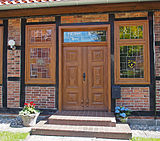front door

A front door is
- in the case of a single-family house or terraced house, the door leading into the house from the community property or garden .
- In the case of a multi-party house (also known as the front gate in Austria ), the door leading from the community property or garden to the communally used parts (hallway, stairwell; in the case of apartment ownership / apartment ownership law, joint property ). It is - also legally - to be separated from the apartment door.
Occasionally you will also find a second one with a ramp for the transport of heavy loads . When converting old houses with a raised ground floor , a second, ground-level entrance and access to the elevator are sometimes installed.
In common parlance, the terms front door and apartment door are often not properly separated, although they are legally to be assessed independently.
Conceptual separation
The front door is the access control that is solely assigned to the general area and whose maintenance and repair is the responsibility of the property management and the owners jointly. The private property begins only on the inside of the door , which in Germany the private ownership is attributed.
Both doors are usually closed by a security key . A locking system is often used in modern houses , whereby both house and apartment doors, sometimes also letter boxes and possibly common rooms can be locked with one key .
materials
House doors in German-speaking countries are now made from the following materials: plastic, aluminum and wood. There are also the material combinations wood-aluminum and plastic-aluminum, which each combine the advantages of the two materials used. Front doors made of steel are not found in residential buildings. Plastic house doors are inexpensive and easy to care for. The locking options are the same as for the other materials. The coloring is done through foil lamination, but is limited. Plastic house doors are more limited in size than house doors made from other materials. Today aluminum house doors combine excellent thermal insulation with robustness and design diversity. The largely unrestricted coloring is done via powder coating. House doors made of wood are made of coniferous woods such as pine, spruce and larch, as well as hardwoods such as oak, meranti or eucalyptus globulus.
Locking
A triple safety lock is standard in German-speaking countries today, in which, after the door has been locked, a bolt in combination with two steel swivel hooks or two bolts on the lock side in the locking parts grip into the frame. A five-point lock therefore means two additional hooks or bolts. Instead of a chain, a door catch or a door gap safety device is integrated today if required. Turning a knob on the inside of the door prevents the door from being opened wide, just a crack. This can be used to determine whether you want to let the outsider in or not. An electric door opener is an electromagnetic mechanism which - if the door is not locked - releases the strike plate in the event of an impulse, which opens the door for the visitor. The electric door opener usually has an additional function, the so-called day latch function, a small pin or button that can be actuated and thus generally releases the strike plate. In order to increase the burglary protection, profile cylinders according to DIN 18252 should be installed in the door. When installed, such cylinders protrude no more than 3 mm and make it significantly more difficult for burglars to open the door.
See also
Web links
Individual evidence
- ↑ Condominium ( Doors section )
- ↑ a b front door
- ↑ House doors made of plastic, aluminum or wood: materials in comparison build.de guide. Retrieved June 17, 2015
- ↑ Modern house doors have to meet several requirements. ZBO - Central Construction Organization, accessed on August 25, 2016 .


